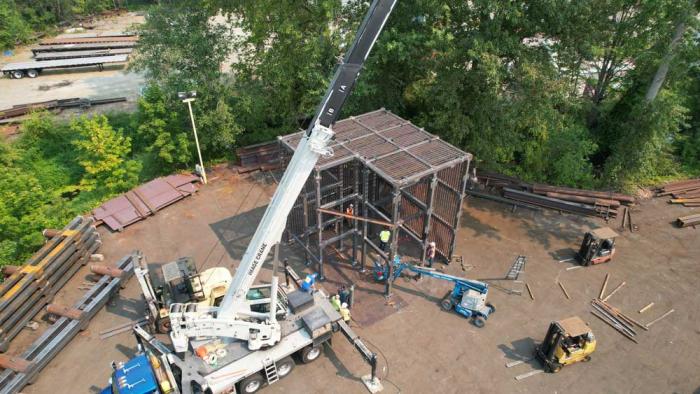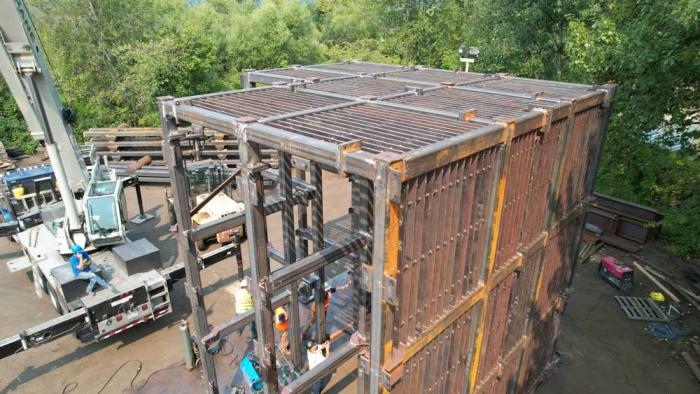Breathtaking work nearly 300 feet underwater
Nearly 300 feet under the surface of Gross Reservoir northwest of Denver, a team of daredevils are embarking on a remodeling job far beyond the reach of the crafty deck guy you found on Nextdoor.
Over about two months, this courageous crew of divers, doctors and demolitionists will deconstruct and remove a massive underwater grate located at the bottom of the water side of the dam, then replace it with an upgraded one. And the entire project will be directed from a floating barge.
The craziest part of all?
The divers will spend weeks working underwater and, between shifts, living in a saturation chamber on the barge that will allow them to eat, sleep and “relax” in a pressurized state and complete the work far faster than if divers had to undergo more frequent preparation and recovery for underwater work shifts.
Watch this video about a similar underwater maintenance project conducted at Denver Water’s Strontia Springs Dam in Waterton Canyon in 2017.
“It is risky work,” said Denver Water engineering manager Doug Raitt. “That said, the risks are manageable. We understand them and our contractor has extraordinary experience.”
If you take a few minutes to learn about the profession of “saturation diving,” (try this 2018 piece published by Atlas Obscura) it may renew your appreciation for your desk job.
Denver Water is contracting with Seattle-based Global Diving and Salvage, a firm with extensive experience in this kind of work.
Other jobs featured on the company’s website include wreck removals, underwater needs tied to energy industry, environmental projects, and work associated with dams, including work on other Denver Water dams.
“It is a niche industry, and we are pretty picky about who we hire to do this,” Raitt said.
The underwater grate at Gross — known by the unflattering name in the industry as a “trashrack” — remains in good shape all these years after it was installed in the early 50s, along with construction of the dam itself.
Its purpose: keeping big debris such as submerged logs from getting pulled into the intricate piping and valve system that calibrates water releases from the bottom of the reservoir.
The trashrack’s structure itself is perfectly sound, in other words, but it no longer aligns with new regulations associated with the Division of Water Resources and the Federal Energy Regulatory Commission. Those regulations involve new design criteria to meet seismic standards, and the grate’s ability to hold up in a theoretically significant and extremely rare earthquake, one that has a 1 in 10,000 chance of occurring in any given year.
Denver Water’s Dam Safety team performs regular, routine inspections on the utility's 20 dams on an annual basis in coordination with the State Engineer’s Office. Read more about the team’s work.
“Dam safety is a black and white world,” Raitt said. “It’s unacceptable to Denver Water to have a feature on a tall dam like this that does not meet the latest regulations. That’s part of the responsibility of maintaining a structure like this. Regulations evolve. When they change, a dam operator like Denver Water has to comply.”
Raitt stresses the project is wholly unrelated to the planned expansion of Gross Reservoir. It would be happening regardless of that effort, he said.
It’s the same situation that applied to Denver Water’s recent upgrade of the dam’s outlet works to better regulate water released from the reservoir. That project, too, had to move ahead regardless of expansion plans.
Workers will begin mobilizing at the reservoir Aug. 23. Much of the initial work will be setting up the floating barge and getting equipment in place. The diving work itself will take roughly a month. The project is expected to be wrapped up in the first week of November.
The work will also create some disruptions to recreation.
From Aug. 23 to Sept. 6, the road to the Windy Point and South Side Picnic Areas will be closed. Osprey Point and the Miramonte Picnic Area will remain open.
After Sept. 6, the road will reopen but there will be no public access at the South Side picnic area (the lower parking lot on the south side of the dam) for the remainder of the project.



